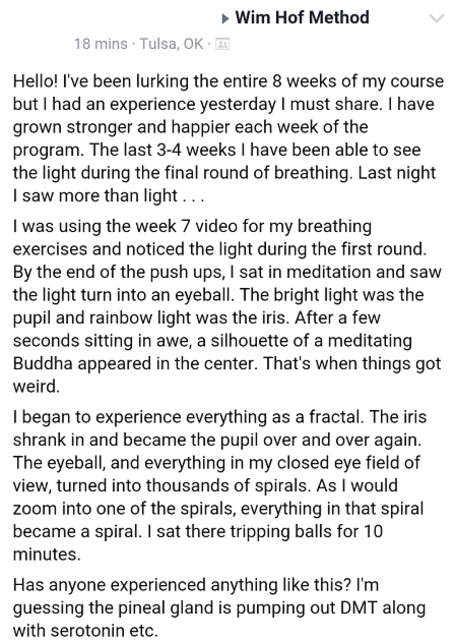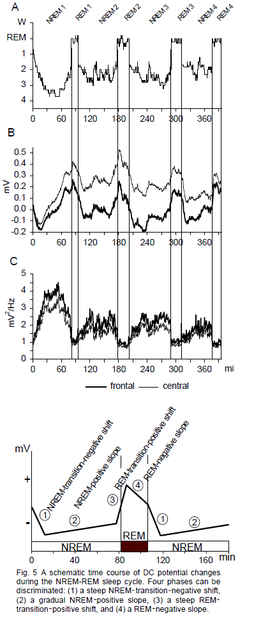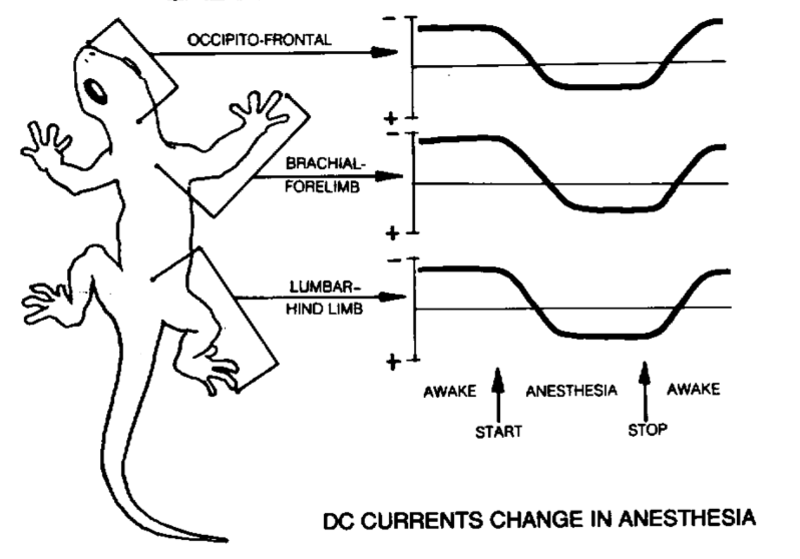Let me be clear that this is not a competition between the sleep cycle and the “Wim Hof Method” but rather a basic comparison of both.
Sleep cycles consist of five phases labeled as stages 1, 2, 3, 4, and REM (Rapid Eye Movement) sleep. Stage 1 is considered the beginning of the sleep cycle which is perceived as “light sleep” in which we drift in and out of sleep and can be awakened easily. Stage 2 is characterized as a further increase of slow wave production in the brain and deeper sleep with occasional bursts of rapid waves called sleep spindles. In Stage 3, the slowest brain waves (delta) begin to show their formation interspersed with smaller, faster waves. Stage 4 consists of delta waves exclusively. Both Stages 3 and 4 are characterized as “deep sleep” in which it’s difficult to wake a person. The next stage is REM sleep which we characterize as our predominant “dream” state.
Each sleep cycle of stages 1-4 + REM sleep takes approximately 90 to 110 minutes to complete. A full night of sleep consists of experiencing 4 to 5 sleep cycles in which REM sleep duration increases with each cycle.
In DMT Quest’s 2015 interview with author of the book “DMT: The Spirit Molecule” Dr. Rick Strassman, he stated “We have known for nearly 60 years that the lungs make DMT.” This would seem pertinent as it pertains to the observation of sleep cycles and fluctuations in respiration rate. While it hasn’t been scientifically verified in humans yet, it has been widely hypothesized that DMT plays a role in generating our “dream” states of sleep. This doesn’t seem far-fetched as we are clearly experiencing “hallucinations” during these states and there has yet to be another endogenous psychedelic compound identified to occur naturally within humans.
It is our hypothesis that since DMT is made in the lungs and our normal waking state doesn’t normally tend to generate psychedelic experiences, there is likely a measurable, observable fluctuation in respiration rate that leads to elevated DMT formation.
In 2009, a study published in the journal Physiological Measurement showcased the undeniable correlation between increased respiration rate/rhythm in accordance with REM sleep.
(Figure 3 from the Study)

In 2010, a study in the journal Advances in Experimental Medicine & Biology would also observe a significant correlation with increase in breathing rate related to REM sleep duration.
(Figure 2 from the Study)

Based on the data available from both studies it would appear that there are moments during the longest REM periods in which increased respiration rate occurs for roughly 45 minutes. During these moments the breaths per minute appears to hover between 17 and 18 on average. In the 2010 study, the raw data showcases bursts of up to 30 breaths per minute. This would unequivocally be described as moments of hyperventilation. The fact that these moments coincide with our most vivid “dream” states would lead us to believe that DMT is being synthesized in elevated amounts during these moments. The fact that hyperventilation correlates with a state labeled as “respiratory alkalosis” in which pH levels are elevated due to suppressed carbon dioxide levels points to DMT formation as potentially being pH related. There are undoubtedly measurable hormonal, neurotransmitter, ionic, and electrical fluctuations during these moments but we will keep it basic for this piece. There is also little need to cover the immense, multi-pronged health benefits from sustained natural sleep as this is common knowledge.
At it’s most basic… sleep appears to consists of prolonged moments of darkness, stillness and relaxation (muscle atonia) coupled with 4 to 5 breathing rounds varying from 10 to 45 minutes in duration.
The question becomes… what kind of experiences might a person have if they were to mimic these same physiological mechanisms and general environment when in a conscious waking state?
This leads us to the “Wim Hof Method” (WHM).
This is a breath based technique developed by 26 Guinness World Record Holder Wim “The Iceman” Hof. While there are additional components to the WHM including visualization, physical exercises, perceived CSF movement manipulation, and cold immersion training… breathing exercises dominate the core of this method.
The breath technique consists of breathing in (moderately deep) twice the volume as you breath out. After completing an average of 30 breaths in this format, you take one large breath and then completely exhale all of the air. Keep the exhale for as long as you can then on the next breath inhale deeply and retain the breath for 10 to 15 seconds prior to exhaling. This is considered “one round”. According to “WHM” practitioners, the number of rounds can vary from as little as 5 rounds up to 50 rounds or more followed by meditation which is comprised of closing one’s eyes and focusing on the area slightly above and between the eyes.
(Here is an example of the breathing technique of the WHM)
Based on rough calculations, if 30 breaths are experienced in 2 minutes + 30 second retention it would take about 10 minutes for 4 rounds of WHM. This would be comparable to 10 minute moments of REM sleep. The obvious difference being that REM sleep is preceded by Stages 1, 2, 3, & 4 of slowing EEG waves. It’s interesting to note a 1992 study in the journal Electroencephalography and Clinical Neurophysiology that observed EEG changes induced by hyperventilation. The results were as follows: “In the hyperventilation group the blood flow velocity decreased to 63% of the initial value and the qEEG showed a marked increase in delta and theta activity (P less than 0.01), but a non-significant change in alpha peak frequency.
While sleep is preceded by a waking, conscious state of Beta/Alpha waves, REM sleep is preceded by Theta/Delta activity in sleep stages 1-4. It’s interesting to note that hyperventilation within itself can induce amplification of Theta and Delta waves during conscious states. This would in turn lead to feelings of deep relaxation and mimic the brain waves of sleep stages 1-4
While there are some definitive differences between the sleep cycle and WHM, it seems as though there is definite overlap in terms of overall physical mechanisms taking place. This brings us back to the hypothesis of REM sleep coinciding with endogenous DMT release. Since it would appear clear that REM sleep triggers significant increase in respiration rate which overlaps with WHM, it should be no surprise when anecdotal reports such as this are shared (from the WHM Facebook Group):

At it’s most basic (likely overly basic) it would appear that WHM simulates REM sleep respiration but when in a conscious waking state rather than unconscious. While it’s no secret that melatonin levels tend to peak at night during sleep, it might surprise some people to know that dopamine levels surge during REM sleep. This is interesting based on the perceived antagonistic relationship between melatonin and dopamine. Perhaps there is a relationship between simultaneous elevated levels of melatonin & dopamine coinciding with DMT release.
The biggest hurdle in terms of designing a scientific study comparing endogenous DMT during sleep and/or WHM is the invasive nature of testing. It’s been proposed that CSF (cerebrospinal fluid) could be a reliable fluid to test for elevated DMT. However, extracting this from a human via spinal tap has it’s drawbacks as continuous monitoring of fluctuating levels is unrealistic not to mention it’s painful, disruptive nature. Blood has been considered as another potential fluid to test for levels of DMT. Unfortunately the levels are in such trace amounts it is projected to be difficult to derive any clear conclusion from the extraction. However, it would remain logical that there should be measurable changes (regardless of amounts) in terms of DMT levels during the day vs. sleep, pre-REM, REM, and post-REM.
The question of location of blood sampling would appear important as venous blood vs. arterial blood might carry significant differences in terms of measurable DMT. This hypothesis is based on the notion that if DMT is synthesized in the lungs followed by rapid uptake by the brain, it would likely mean that this blood pathway should be considered optimal to draw samples from. By comparison, any blood that has traveled through the liver would likely be mostly devoid of DMT as it is broken down via MAO (monamine oxidase). Unfortunately the carotid artery and the basal artery (the pathway from lungs/heart to brain) is sub-optimal based on depth of location, pain associated with puncture, and potential health hazards associated with extraction.
(Two videos showcasing the flow of blood from lungs/heart/ and brain)
Hopefully advanced blood sampling technology will allow for a less hazardous method of testing for endogenous DMT in the future.
The more important question is… how does elevated endogenous DMT correlate with the “supernormal” physical feats associated with Wim Hof and practitioners of “WHM”? While it’s easy to write-off REM sleep experiences as merely “hallucinations” of the mind, should there be a direct correlation with DMT and “supernormal” feats it changes the game altogether.
Perhaps moments of “Hysterical Strength” correlated with traumatic environmental stress corresponds with quick bursts of endogenous DMT?
Here are a few examples cited from Wikipedia:
In 1982, in Lawrenceville, Georgia, Tony Cavallo was repairing a 1964 Chevrolet Impala automobile from underneath. The vehicle was propped up with jacks, but it fell. Cavallo’s mother, Mrs. Angela Cavallo, lifted the car high enough and long enough for two neighbours to replace the jacks and pull Tony from beneath the car.
In 2006, Ivujivik, Quebec resident Lydia Angiyou saved several children by fighting a polar bear until a local hunter shot it.
In 2006, in Tucson, Arizona, Tom Boyle watched as a Chevrolet Camaro hit 18-year-old Kyle Holtrust. The car pinned Holtrust, still alive, underneath. Boyle lifted the Camaro off the teenager, while the driver of the car pulled the teen to safety.
In 2009, in Ottawa, Kansas, 5 ft 7 in (1.70 m), 185 lb (84 kg; 13.2 st) Nick Harris lifted a Mercury sedan to help a 6-year-old girl pinned
beneath.
In 2011, in Tampa, Florida, 6 ft 3 in (1.91 m), 295 lb (134 kg; 21.1 st) University of South Florida college football player Danous Estenor lifted a 3,500 lb (1,600 kg) car off of a man who had been caught underneath. The man was a tow truck driver who had been pinned under the rear tire of a 1990 Cadillac Seville, which had lurched forward as he worked underneath it. The man suffered only minor injuries.
In 2012, in Glen Allen, Virginia, 22-year-old Lauren Kornacki rescued her father, Alec Kornacki, after the jack used to prop up his BMW slipped, pinning him under it. Lauren lifted the car, then performed CPR on her father and saved his life.
In 2013, in Oregon, teenage sisters Hanna (age 16) & Haylee (age 14)lifted a tractor to save their father pinned underneath.
In 2015, in St. John’s, Newfoundland, Nick Williams lifted a four-wheel-drive vehicle to save a young boy pinned beneath its tire.
In 2015, in Vienna, Virginia, Charlotte Heffelmire was able to momentarily use incredible strength to free her dad from a GMC pick-up truck.
–
Cases like these have been reported throughout history all across the world. Either we can dismiss them as complete fabrications altogether or we can make an attempt to explain the mechanisms of how they transpired. The most intriguing aspect of these cases are the lack of physical harm done to the “superheroes” in these events. This is distinctly different from examples of superhuman strength by those under the influence of PCP. There have been many testaments as to the abnormal, elevated strength of people who have ingested PCP by police officers. However, they also coincide with severe physical damage suffered to their bodies in doing so.
Not to dive too deep into the rabbit hole but the differences between “hysterical strength” cases and “PCP-induced” strength cases could lie in the electrical patterns and direction within the brain & body. A 1998 study in the European Journal of Neuroscience outlines the distinct direct current (DC) changes that take place throughout the brain in our sleep stages including REM.


This might lead to an explanation as to how an average person can lift a car in moments of distress without ripping their arms out of their sockets (as has been reported with PCP users). Perhaps there is a distinct difference in terms of how a person’s body interacts with the environment based on electrical flow which might correlate with electromagnetism. The concept of magnetism and attractive/repulsive forces is the only way I can presume that a person can perform these types of supernormal feats without injuring themselves. It’s intriguing that in many cases, these heroes who have lifted extremely heavy objects claim that during those moments the object felt weightless.
Anyhow… I’ve already digressed from the original point.
The Sleep Cycle (more specifically REM sleep) and the “Wim Hof Method” should be looked at closely in terms hormonal fluctuations, electrical alterations, ionic balance, and overall biological mechanisms as there is the potential for much overlap. The actual testing for DMT is currently a challenging endeavor based on technological limitations. However, it would not seem irrational nor illogical to presume that an endogenous “hallucinogenic” compound is being produced during REM and unexplained visualizations experienced during WHM. Since there has yet to be another naturally produced “psychedelic” molecule found within the human body other than DMT… we can assume that these states are a byproduct of this neurotransmitter/hormone.
Maybe there is some truth to the saying… “he’s unconscious” when a sports hero is performing at an optimal level. It sounds something like a combination of subconscious/superconscious accessibility in moments of abnormal feats. Maybe there are more dormant abilities that we have yet to uncover…
DMT Quest is a non-profit 501(c)3 dedicated to raising awareness and funds for endogenous DMT Research. This specific field of psychedelic research has been underfunded for many decades now. It’s time to take our understanding of human physiology, abilities, and perception to the next level. E-mail me at jchavez@dmtquest.org with any comments or questions. You can also follow us at Facebook, Instagram, or Twitter.
